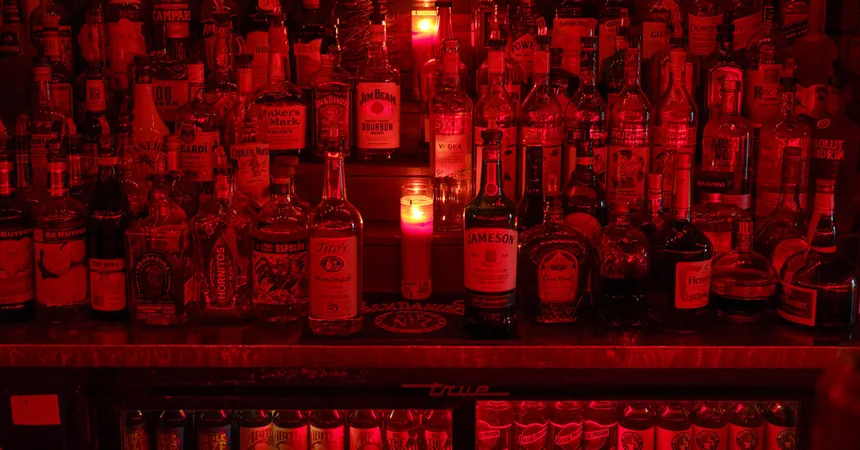
Pandemic Drinking Habits Persist: Are Americans Drinking Their Way into a Crisis?
2024-11-11
Author: Yan
As the COVID-19 pandemic took hold in early 2020, Americans turned to alcohol in unprecedented ways. Faced with anxiety, isolation, and uncertainty, many sought solace in drinking, leading to significant increases in alcohol consumption that continue to this day.
A recent study, published in the Annals of Internal Medicine, reveals that the percentage of Americans consuming alcohol has steadily climbed from 66.3% in 2018 to 69.3% in 2022. During the same period, incidents of heavy and binge drinking also spiked, leaving health experts concerned about the long-term implications of these shifting consumption patterns.
Dr. Brian P. Lee, a hepatologist at the University of Southern California and the lead investigator of the study, noted that initial expectations were based on historical trends following national crises. “Typically, after crises like 9/11 or Hurricane Katrina, we see a return to normal drinking levels. However, that's not the case now,” he explained. The pandemic, he points out, did not just trigger a temporary spike in alcohol use but appears to have embedded deeper patterns of consumption.
With alcohol being a highly addictive substance, the ramifications could be serious. Prior to the pandemic, heavy drinking and alcohol-related liver disease were already on the rise. Shockingly, there was a reported 25% increase in alcohol-related deaths in 2020 alone, underscoring the pandemic's toll on mental health and addiction issues.
The findings from the study are alarming, revealing a stark rise in heavy drinking figures: 6.29% of Americans reported heavy drinking in 2022, compared to 5.1% in 2018. This increase can be seen across demographics, affecting both males and females, all age groups, and various racial and ethnic communities. Notably, the only groups that reported a decline in heavy drinking were Native Americans and Asian Americans.
Diving deeper into demographic trends, white Americans displayed the highest instances of heavy drinking, with 7.34% engaging in such behavior in 2022. The most pronounced rise in heavy drinking was observed among adults aged 40 to 49, where rates climbed from 6.49% in 2020 to 8.23% in 2022. Adults aged 50 to 64 also had concerning rates of heavy drinking at 7.15%.
The study also revealed a worrying trend among women. In 2022, 6.45% of women reported heavy drinking, surpassing their male counterparts at 6.12%. This trend could be attributed to unique stressors faced by women during the pandemic, including increased caregiving responsibilities and mental health pressures. Dr. Divya Ayyala-Somayajula remarked on these challenges, stating, “With limited access to childcare and coping mechanisms, many turned to alcohol to manage their stress.”
While some may view drinking as a socially acceptable stress relief strategy, health experts highlight its harmful, maladaptive nature. The lack of accessible behavioral health services during the pandemic may have exacerbated the situation, especially for those grappling with alcohol use disorders.
As the pandemic’s shadow looms large, the increases in alcohol consumption present a daunting legacy. With compounding issues such as school absenteeism, rising overdose deaths, and persistent mental health problems among young people, the question remains: how will society address this growing addiction crisis? Without intervention and accessible support mechanisms, the consequences of this prolonged drinking spree may be felt for years to come.
As we reflect on the pandemic's impacts, it's crucial to initiate conversations on healthier coping strategies and prioritize mental health resources to help curb these troubling trends. Will you be part of the solution?




 Brasil (PT)
Brasil (PT)
 Canada (EN)
Canada (EN)
 Chile (ES)
Chile (ES)
 España (ES)
España (ES)
 France (FR)
France (FR)
 Hong Kong (EN)
Hong Kong (EN)
 Italia (IT)
Italia (IT)
 日本 (JA)
日本 (JA)
 Magyarország (HU)
Magyarország (HU)
 Norge (NO)
Norge (NO)
 Polska (PL)
Polska (PL)
 Schweiz (DE)
Schweiz (DE)
 Singapore (EN)
Singapore (EN)
 Sverige (SV)
Sverige (SV)
 Suomi (FI)
Suomi (FI)
 Türkiye (TR)
Türkiye (TR)